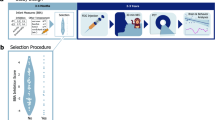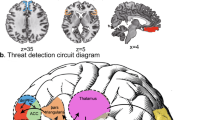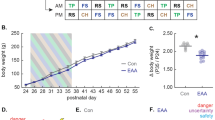Abstract
Children with an anxious temperament are prone to heightened shyness and behavioral inhibition (BI). When chronic and extreme, this anxious, inhibited phenotype is an important early-life risk factor for the development of anxiety disorders, depression and co-morbid substance abuse. Individuals with extreme anxious temperament often show persistent distress in the absence of immediate threat and this contextually inappropriate anxiety predicts future symptom development. Despite its clear clinical relevance, the neural circuitry governing the maladaptive persistence of anxiety remains unclear. Here, we used a well-established nonhuman primate model of childhood temperament and high-resolution 18fluorodeoxyglucose positron emission tomography (FDG-PET) imaging to understand the neural systems governing persistent anxiety and to clarify their relevance to early-life phenotypic risk. We focused on BI, a core component of anxious temperament, because it affords the moment-by-moment temporal resolution needed to assess contextually appropriate and inappropriate anxiety. From a pool of 109 peri-adolescent rhesus monkeys, we formed groups characterized by high or low levels of BI, as indexed by freezing in response to an unfamiliar human intruder’s profile. The high-BI group showed consistently elevated signs of anxiety and wariness across >2 years of assessments. At the time of brain imaging, 1.5 years after initial phenotyping, the high-BI group showed persistently elevated freezing during a 30-min ‘recovery’ period following an encounter with the intruder—more than an order of magnitude greater than the low-BI group—and this was associated with increased metabolism in the bed nucleus of the stria terminalis, a key component of the central extended amygdala. These observations provide a neurobiological framework for understanding the early phenotypic risk to develop anxiety-related psychopathology, for accelerating the development of improved interventions, and for understanding the origins of childhood temperament.
This is a preview of subscription content, access via your institution
Access options
Subscribe to this journal
Receive 12 print issues and online access
$259.00 per year
only $21.58 per issue
Buy this article
- Purchase on Springer Link
- Instant access to full article PDF
Prices may be subject to local taxes which are calculated during checkout




Similar content being viewed by others
References
Clauss JA, Blackford JU . Behavioral inhibition and risk for developing social anxiety disorder: a meta-analytic study. J Am Acad Child Adolesc Psychiatry 2012; 51: 1066–1075.
Pine DS, Fox NA . Childhood antecedents and risk for adult mental disorders. Annu Rev Psychol 2015; 66: 459–485.
Insel TR . Next-generation treatments for mental disorders. Sci Transl Med 2012; 4: 155ps119.
Kagan J, Reznick JS, Snidman N . Biological bases of childhood shyness. Science 1988; 240: 167–171.
Fox AS, Kalin NH . A translational neuroscience approach to understanding the development of social anxiety disorder and its pathophysiology. Am J Psychiatry 2014; 171: 1162–1173.
Fox AS, Shelton SE, Oakes TR, Davidson RJ, Kalin NH . Trait-like brain activity during adolescence predicts anxious temperament in primates. PLoS ONE 2008; 3: e2570.
Oler JA, Fox AS, Shackman AJ, Kalin NH. The central nucleus of the amygdala is a critical substrate for individual differences in anxiety. In: Amaral DG, Adolphs R (eds). Living Without an Amygdala. Guilford: NY, 2016.
Buss KA, Kiel EJ. Temperamental risk factors for pediatric anxiety disorders. In: Vasa RA, Roy AK (eds). Pediatric Anxiety Disorders: A Clinical Guide. Springer: NY, 2013, pp 47–68.
Shackman AJ, Tromp DPM, Stockbridge MD, Kaplan CM, Tillman RM, Fox AS . Dispositional negativity: an integrative psychological and neurobiological perspective. Psychol Bull (in press).
Davidson RJ, Jackson DC, Kalin NH . Emotion, plasticity, context, and regulation: Perspectives from affective neuroscience. Psychol Bull 2000; 126: 890–909.
Davis M, Walker DL, Miles L, Grillon C . Phasic vs sustained fear in rats and humans: role of the extended amygdala in fear vs anxiety. Neuropsychopharmacology 2010; 35: 105–135.
Duits P, Cath DC, Lissek S, Hox JJ, Hamm AO, Engelhard IM et al. Updated meta-analysis of classical fear conditioning in the anxiety disorders. Depress Anxiety 2015; 239–253.
Grupe DW, Nitschke JB . Uncertainty and anticipation in anxiety: an integrated neurobiological and psychological perspective. Nat Rev Neurosci 2013; 14: 488–501.
Barker TV, Reeb-Sutherland BC, Fox NA . Individual differences in fear potentiated startle in behaviorally inhibited children. Dev Psychobiol 2014; 56: 133–141.
Reeb-Sutherland BC, Helfinstein SM, Degnan KA, Perez-Edgar K, Henderson HA, Lissek S et al. Startle response in behaviorally inhibited adolescents with a lifetime occurrence of anxiety disorders. J Am Acad Child Adolesc Psychiatry 2009; 48: 610–617.
Waters AM, Nazarian M, Mineka S, Zinbarg RE, Griffith JW, Naliboff B et al. Context and explicit threat cue modulation of the startle reflex: preliminary evidence of distinctions between adolescents with principal fear disorders versus distress disorders. Psychiatry Res 2014; 217: 93–99.
Jovanovic T, Nylocks KM, Gamwell KL, Smith A, Davis TA, Norrholm SD et al. Development of fear acquisition and extinction in children: effects of age and anxiety. Neurobiol Learn Mem 2014; 113: 135–142.
Reznick JS, Kagan J, Snidman N, Gersten M, Baak K, Rosenberg A . Inhibited and uninhibited children: A follow-up study. Child Dev 1986; 57: 660–680.
Buss KA, Davis EL, Kiel EJ, Brooker RJ, Beekman C, Early MC . Dysregulated fear predicts social wariness and social anxiety symptoms during kindergarten. J Clin Child Adolesc Psychol 2013; 42: 603–616.
Grillon C . Associative learning deficits increase symptoms of anxiety in humans. Biol Psychiatry 2002; 51: 851–858.
Houben M, Van Den Noortgate W, Kuppens P . The relation between short-term emotion dynamics and psychological well-being: a meta-analysis. Psychol Bull 2015; 141: 901–930.
Newman MG, Fisher AJ . Mediated moderation in combined cognitive behavioral therapy versus component treatments for generalized anxiety disorder. J Consult Clin Psychol 2013; 81: 405–414.
van de Leemput IA, Wichers M, Cramer AO, Borsboom D, Tuerlinckx F, Kuppens P et al. Critical slowing down as early warning for the onset and termination of depression. Proc Natl Acad Sci USA 2014; 111: 87–92.
Shackman AJ, Fox AS . Contributions of the central extended amygdala to fear and anxiety. J Neurosci 36: 8050–8063.
Duvarci S, Bauer EP, Pare D . The bed nucleus of the stria terminalis mediates inter-individual variations in anxiety and fear. J Neurosci 2009; 29: 10357–10361.
Kim SY, Adhikari A, Lee SY, Marshel JH, Kim CK, Mallory CS et al. Diverging neural pathways assemble a behavioural state from separable features in anxiety. Nature 2013; 496: 219–223.
Botta P, Demmou L, Kasugai Y, Markovic M, Xu C, Fadok JP et al. Regulating anxiety with extrasynaptic inhibition. Nat Neurosci 2015; 18: 1493–1500.
Shackman AJ, Fox AS, Oler JA, Shelton SE, Davidson RJ, Kalin NH . Neural mechanisms underlying heterogeneity in the presentation of anxious temperament. Proc Natl Acad Sci USA 2013; 110: 6145–6150.
Fox AS, Oler JA, Shackman AJ, Shelton SE, Raveendran M, McKay DR et al. Intergenerational neural mediators of early-life anxious temperament. Proc Natl Acad Sci USA 2015; 112: 9118–9122.
Fox NA, Henderson HA, Marshall PJ, Nichols KE, Ghera MM . Behavioral inhibition: linking biology and behavior within a developmental framework. Annu Rev Psychol 2005; 56: 235–262.
Gibbs RA, Rogers J, Katze MG, Bumgarner R, Weinstock GM, Mardis ER et al. Evolutionary and biomedical insights from the rhesus macaque genome. Science 2007; 316: 222–234.
Preuss TM. Primate brain evolution in phylogenetic context. In: Kaas JH, Preuss TM (eds). Evolution of Nervous Sytems vol. 4. Elsevier: NY, 2007, pp 3–34.
Fox AS, Oler JA, Tromp DP, Fudge JL, Kalin NH . Extending the amygdala in theories of threat processing. Trends Neurosci 2015; 38: 319–329.
deCampo DM, Fudge JL . Amygdala projections to the lateral bed nucleus of the stria terminalis in the macaque: comparison with ventral striatal afferents. J Comp Neurol 2013; 521: 3191–3216.
Kalin NH, Shelton SE . Defensive behaviors in infant rhesus monkeys: environmental cues and neurochemical regulation. Science 1989; 243: 1718–1721.
Rilling JK, Winslow JT, O'Brien D, Gutman DA, Hoffman JM, Kilts CD . Neural correlates of maternal separation in rhesus monkeys. Biol Psychiatry 2001; 49: 146–157.
Kalin NH, Shelton SE, Fox AS, Rogers J, Oakes TR, Davidson RJ . The serotonin transporter genotype is associated with intermediate brain phenotypes that depend on the context of eliciting stressor. Mol Psychiatry 2008; 13: 1021–1027.
Jahn AL, Fox AS, Abercrombie HC, Shelton SE, Oakes TR, Davidson RJ et al. Subgenual prefrontal cortex activity predicts individual differences in hypothalamic-pituitary-adrenal activity across different contexts. Biol Psychiatry 2010; 67: 175–181.
Oler JA, Fox AS, Shelton SE, Christian BT, Murali D, Oakes TR et al. Serotonin transporter availability in the amygdala and bed nucleus of the stria terminalis predicts anxious temperament and brain glucose metabolic activity. J Neurosci 2009; 29: 9961–9966.
Preacher KJ, Rucker DD, MacCallum RC, Nicewander WA . Use of the extreme groups approach: a critical reexamination and new recommendations. Psychol Methods 2005; 10: 178–192.
Kalin NH, Shelton SE, Davidson RJ . Role of the primate orbitofrontal cortex in mediating anxious temperament. Biol Psychiatry 2007; 62: 1134–1139.
Kalin NH, Shelton SE, Davidson RJ . The role of the central nucleus of the amygdala in mediating fear and anxiety in the primate. J Neurosci 2004; 24: 5506–5515.
Chronis-Tuscano A, Degnan KA, Pine DS, Perez-Edgar K, Henderson HA, Diaz Y et al. Stable early maternal report of behavioral inhibition predicts lifetime social anxiety disorder in adolescence. J Am Acad Child Adolesc Psychiatry 2009; 48: 928–935.
Nichols T, Brett M, Andersson J, Wager T, Poline JB . Valid conjunction inference with the minimum statistic. Neuroimage 2005; 25: 653–660.
Birn RM, Shackman AJ, Oler JA, Williams LE, McFarlin DR, Rogers GM et al. Evolutionarily‐conserved dysfunction of prefrontal‐amygdalar connectivity in early‐life anxiety. Mol Psychiatry 2014; 19: 915–922.
Davis M, Whalen PJ . The amygdala: vigilance and emotion. Mol Psychiatry 2001; 6: 13–34.
Walker DL, Davis M . Role of the extended amygdala in short-duration versus sustained fear: a tribute to Dr. Lennart Heimer. Brain Struct Funct 2008; 213: 29–42.
Nagy FZ, Pare D . Timing of impulses from the central amygdala and bed nucleus of the stria terminalis to the brain stem. J Neurophysiol 2008; 100: 3429–3436.
Somerville LH, Whalen PJ, Kelley WM . Human bed nucleus of the stria terminalis indexes hypervigilant threat monitoring. Biol Psychiatry 2010; 68: 416–424.
Straube T, Mentzel HJ, Miltner WHR . Waiting for spiders: Brain activation during anticipatory anxiety in spider phobics. Neuroimage 2007; 37: 1427–1436.
Yassa MA, Hazlett RL, Stark CE, Hoehn-Saric R . Functional MRI of the amygdala and bed nucleus of the stria terminalis during conditions of uncertainty in generalized anxiety disorder. J Psychiatr Res 2012; 46: 1045–1052.
Munsterkotter AL, Notzon S, Redlich R, Grotegerd D, Dohm K, Arolt V et al. Spider or no spider? Neural correlates of sustained and phasic fear in spider phobia. Depress Anxiety 2015; 32: 656–663 (in press).
Kalin NH, Shelton SE, Fox AS, Oakes TR, Davidson RJ . Brain regions associated with the expression and contextual regulation of anxiety in primates. Biol Psychiatry 2005; 58: 796–804.
Somerville LH, Wagner DD, Wig GS, Moran JM, Whalen PJ, Kelley WM . Interactions between transient and sustained neural signals support the generation and regulation of anxious emotion. Cereb Cortex 2013; 23: 49–60.
McMenamin BW, Langeslag SJ, Sirbu M, Padmala S, Pessoa L . Network organization unfolds over time during periods of anxious anticipation. J Neurosci 2014; 34: 11261–11273.
Alvarez RP, Kirlic N, Misaki M, Bodurka J, Rhudy JL, Paulus MP et al. Increased anterior insula activity in anxious individuals is linked to diminished perceived control. Transl Psychiatry 2015; 5: e591.
Buss KA . Which fearful toddlers should we worry about? Context, fear regulation, and anxiety risk. Dev Psychol 2011; 47: 804–819.
Wolitzky-Taylor K, Vrshek-Schallhorn S, Waters AM, Mineka S, Zinbarg R, Ornitz E et al. Adversity in early and mid-adolescence is associated with elevated startle responses to safety cues in late adolescence. Clin Psychol Sci 2014; 2: 202–213.
Craske MG, Wolitzky-Taylor KB, Mineka S, Zinbarg R, Waters AM, Vrshek-Schallhorn S et al. Elevated responding to safe conditions as a specific risk factor for anxiety versus depressive disorders: evidence from a longitudinal investigation. J Abnorm Psychol 2012; 121: 315–324.
Lenaert B, Boddez Y, Griffith JW, Vervliet B, Schruers K, Hermans D . Aversive learning and generalization predict subclinical levels of anxiety: a six-month longitudinal study. J Anxiety Disord 2014; 28: 747–753.
LeDoux JE . Anxious: Using the Brain to Understand and Treat Fear and Anxiety. Viking: NY, 2015.
Mobbs D, Yu R, Rowe JB, Eich H, FeldmanHall O, Dalgleish T . Neural activity associated with monitoring the oscillating threat value of a tarantula. Proc Natl Acad Sci USA 2010; 107: 20582–20586.
Grupe DW, Oathes DJ, Nitschke JB . Dissecting the anticipation of aversion reveals dissociable neural networks. Cereb Cortex 2013; 23: 1874–1883.
Choi JM, Padmala S, Pessoa L . Impact of state anxiety on the interaction between threat monitoring and cognition. Neuroimage 2012; 59: 1912–1923.
Klumpers F, Kroes MC, Heitland I, Everaerd D, Akkermans SE, Oosting RS et al. Dorsomedial prefrontal cortex mediates the impact of serotonin transporter linked polymorphic region genotype on anticipatory threat reactions. Biol Psychiatry 2015; 78: 582–589.
Fox AS, Shelton SE, Oakes TR, Converse AK, Davidson RJ, Kalin NH . Orbitofrontal cortex lesions alter anxiety-related activity in the primate bed nucleus of stria terminalis. J Neurosci 2010; 30: 7023–7027.
Shackman AJ, Salomons TV, Slagter HA, Fox AS, Winter JJ, Davidson RJ . The integration of negative affect, pain and cognitive control in the cingulate cortex. Nat Rev Neurosci 2011; 12: 154–167.
Mobbs D, Hagan CC, Dalgleish T, Silston B, Prevost C . The ecology of human fear: survival optimization and the nervous system. Front Neurosci 2015; 9: 55.
McLean CP, Asnaani A, Litz BT, Hofmann SG . Gender differences in anxiety disorders: prevalence, course of illness, comorbidity and burden of illness. J Psychiatr Res 2011; 45: 1027–1035.
Gater R, Tansella M, Korten A, Tiemens BG, Mavreas VG, Olatawura MO . Sex differences in the prevalence and detection of depressive and anxiety disorders in general health care settings: report from the World Health Organization Collaborative Study on Psychological Problems in General Health Care. Arch Gen Psychiatry 1998; 55: 405–413.
Avery SN, Clauss JA, Blackford JU . The human BNST: Functional role in anxiety and addiction. Neuropsychopharmacology 2016; 41: 126–141.
Mai JK, Paxinos G, Voss T . Atlas of the Human Brain, 3rd edn. Academic Press: San Diego, CA, 2007.
Paxinos G, Huang X, Petrides M, Toga A . The Rhesus Monkey Brain in Stereotaxic Coordinates 2nd edn. Academic Press: San Diego, 2009.
Avery SN, Clauss JA, Winder DG, Woodward N, Heckers S, Blackford JU . BNST neurocircuitry in humans. Neuroimage 2014; 91: 311–323.
Torrisi S, O'Connell K, Davis A, Reynolds R, Balderston N, Fudge JL et al. Resting state connectivity of the bed nucleus of the stria terminalis at ultra-high field. Hum Brain Mapp 2015; 36: 4076–4088.
Klein A, Andersson J, Ardekani BA, Ashburner J, Avants B, Chiang MC et al. Evaluation of 14 nonlinear deformation algorithms applied to human brain MRI registration. Neuroimage 2009; 46: 786–802.
Caspi A, Roberts BW, Shiner RL . Personality development: stability and change. Annu Rev Psychol 2005; 56: 453–484.
Gross JJ, Sutton SK, Ketelaar T . Relations between affect and personality: support for the affect-level and affective reactivity views. Pers Soc Psychol Bull 1998; 24: 279–288.
Suls J, Martin R . The daily life of the garden-variety neurotic: reactivity, stressor exposure, mood spillover, and maladaptive coping. J Pers 2005; 73: 1485–1509.
Bolger N, Schilling EA . Personality and the problems of everyday life: the role of neuroticism in exposure and reactivity to daily stressors. J Pers 1991; 59: 355–386.
Luck SJ. Ten simple rules for designing ERP experiments. In: Handy TC (ed). Event-Related Potentials: A Methods Handbook. MIT Press: Cambridge, MA, 2005, pp 17–32.
Shackman AJ, Sarinopoulos I, Maxwell JS, Pizzagalli DA, Lavric A, Davidson RJ . Anxiety selectively disrupts visuospatial working memory. Emotion 2006; 6: 40–61.
Crapse TB, Sommer MA . Corollary discharge across the animal kingdom. Nat Rev Neurosci 2008; 9: 587–600.
Maren S, Phan KL, Liberzon I . The contextual brain: implications for fear conditioning, extinction and psychopathology. Nat Rev Neurosci 2013; 14: 417–428.
Acknowledgements
Authors acknowledge assistance and critical feedback from A Alexander, A Converse, L Friedman, D Grupe, R Hoks, T Johnson, S Mansavage, K Meyer, L Pessoa, D Pine, P Rudebeck, W Shelledy, M Stockbridge, T Johnstone, E Zao and the staffs of the Harlow Center for Biological Psychology, HealthEmotions Research Institute (HERI), and Wisconsin National Primate Center. We are particularly grateful for the contributions of Helen Van Valkenberg to this work. This work was supported by the National Institutes of Health (DA040717, HD003352, HD008352, MH018931, MH046729, MH069315, MH081884, MH084051, MH091550, MH107444, OD011106 and RR000167), HERI, Meriter Hospital and University of Maryland.
Author contributions
NHK and SES designed the study. RJD provided theoretical guidance. SES collected data. ASF processed data. AJS, ASF, TRO and NHK analyzed data. ASF and TRO developed analytical tools. AJS, ASF, NHK, JAO and RJD contributed to data interpretation. AJS, ASF and NHK wrote the paper. AJS and ASF created figures and tables. NHK supervised the study. All authors reviewed and revised the paper
Author information
Authors and Affiliations
Corresponding author
Ethics declarations
Competing interests
The authors declare no conflict of interest.
Additional information
Supplementary Information accompanies the paper on the Molecular Psychiatry website
Supplementary information
Rights and permissions
About this article
Cite this article
Shackman, A., Fox, A., Oler, J. et al. Heightened extended amygdala metabolism following threat characterizes the early phenotypic risk to develop anxiety-related psychopathology. Mol Psychiatry 22, 724–732 (2017). https://doi.org/10.1038/mp.2016.132
Received:
Revised:
Accepted:
Published:
Issue Date:
DOI: https://doi.org/10.1038/mp.2016.132
This article is cited by
-
A preliminary study of the effects of an antimuscarinic agent on anxious behaviors and white matter microarchitecture in nonhuman primates
Neuropsychopharmacology (2024)
-
The hidden link between circadian entropy and mental health disorders
Translational Psychiatry (2022)
-
Freezing of gaze during action preparation under threat imminence
Scientific Reports (2019)
-
Acute alcohol administration dampens central extended amygdala reactivity
Scientific Reports (2018)
-
A multi-dimensional characterization of anxiety in monozygotic twin pairs reveals susceptibility loci in humans
Translational Psychiatry (2017)



